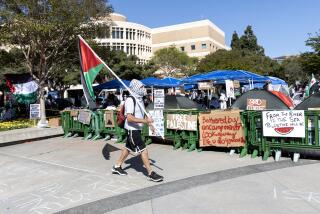Complaints Prompt Study on Chapman’s Uses of Properties
- Share via
After a parade of angry residents vehemently criticized Chapman College, the Orange Planning Commission on Monday night ordered its staff to further study the college’s use of former houses on the edge of the campus.
The commission also deferred action on the college’s request to bring the 13 former residential properties into conformance with city zoning ordinances. The college had sought conditional-use permits for the properties on Walnut Avenue and Center Street near the city’s Old Towne residential area.
The homes, built in the 1920s through the ‘40s, have been used for offices, maintenance equipment, child care and a variety of college needs for many years. The dispute over the non-residential uses, which are not allowed under current zoning in Orange, has rekindled a two-year battle between Old Towne residents and the college.
Some who testified Monday night accused Chapman College officials of “harassment” and of trying to force other area homeowners to sell their property to the growing college. Some also said their property values were being undercut by the neighboring college parcels.
But Thomas D. Beck, associate vice president for planning at the college, responded that the college is trying to be a good neighbor and that property values are escalating in the neighborhood. One home adjoining a college property recently went on the market for $179,000. “It is the sort of building we would offer $130,000 to $150,000 for,” Beck said.
College officials previously had acknowledged that permits should have been obtained for the properties years ago but were overlooked by “inadvertent oversight,” Beck said, adding that some of the properties were acquired by the college as long ago as 1954--before the city’s current zoning laws for the area.
“Our concern and desire . . . is to get into conformity and stay in conformity,” he told the commission.
But 11 Old Towne residents who testified urged commissioners not to grant the college’s request for conditional-use permits until it could explain more thoroughly its uses of some of the former houses.
“This is a very sad situation,” said Harold Frederick, a resident of the area. “Chapman College lately has turned out to be a bad neighbor. What they’ve asked you to do is to sanction what they’ve already done.”
Some of the neighbors who testified against the college implied that Chapman is using at least one piece of property to store dangerous and possibly toxic materials--a charge that Beck categorically denied Monday night. The criticism centered on a maintenance shed on one of properties along North Center Street.
Several neighbors charged that the shed exudes paint fumes and that “suspicious” barrels of materials have been seen on the property. One woman charged that her husband’s throat cancer may have stemmed from exposure to the materials stored on the premises.
None in the audience of about 50 people at the commission’s regular meeting spoke in favor of the college. The first opponent to speak was Joe Suste, who read a prepared statement that said: “We do not oppose the college. We do not oppose the growth of the college.” But Suste added that residents do oppose “uses of residential property that are incompatible with the neighborhood” and “dangerous materials and activities in our neighborhood.”
Beck, in his testimony, told the commission that the maintenance building is used only for such things as painting furniture and repairing college equipment.
But Suste charged that the building nonetheless poses an environmental danger because of paint fumes and residue from woodworking.
Twelve of the college properties in questions are on the 400 and 500 blocks of North Center Street, and one is in the 300 block of East Walnut Street.
Beck said that college officials failed to get the proper permits because they didn’t realize it was required.
“We didn’t realize the permits hadn’t been obtained, and the city also didn’t know. But now we’re doing our best to get everything in order and do what needs to be done,” he said.
The current dispute is similar to a crisis faced by the college in the fall of 1986, also over a zoning battle.
Old Towne residents protested Chapman College’s proposal for a high-rise, $10-million classroom building, to be called the Learning Center. Residents argued that the high-rise would be out of step with the one- and two-story houses in the neighborhood.
The residential furor led the city Planning Commission to recommend against granting a permit for the building, prompting college officials to express anger and dismay.
Then-college President G. T. (Buck) Smith said Chapman might have to think of moving elsewhere in Orange County if the college was denied the right to build badly needed classrooms.
In the end, the City Council overrode the commission’s recommendation, and on Dec. 9, 1986, approved a scaled down “compromise” high-rise building for the college campus.
Since then, college officials have said they have gone out of their way to be in tune with the residential neighborhood around Chapman. But some Old Towne residents have complained in recent months about Chapman, saying that parking and traffic problems around the college are worsening, rather than improving.
The five-member commission on Monday night continued a decision on the disputed properties to Sept. 7, when commission staff was ordered to return with more information about how the maintenance shed and other properties challenged by residents are used by the college.
Beck said after the meeting that he was not unhappy with the delay and hoped that the information would prove useful in helping to allay residents’ concerns.
More to Read
Sign up for Essential California
The most important California stories and recommendations in your inbox every morning.
You may occasionally receive promotional content from the Los Angeles Times.













